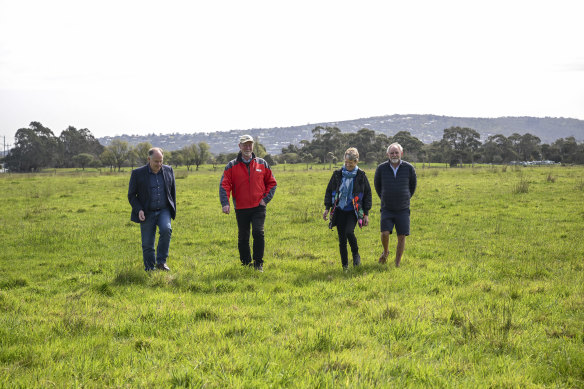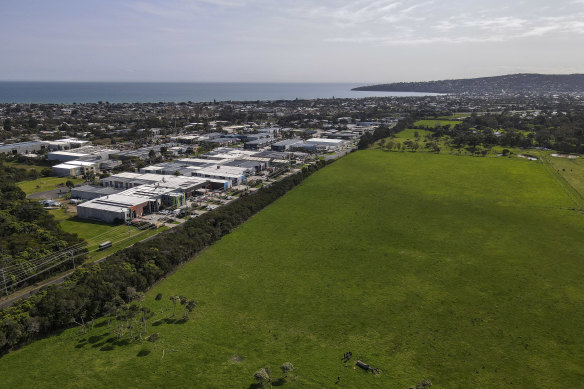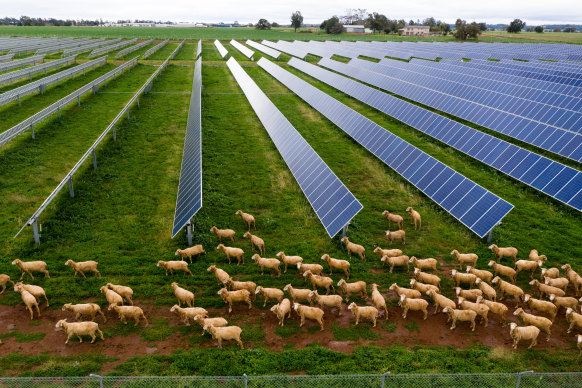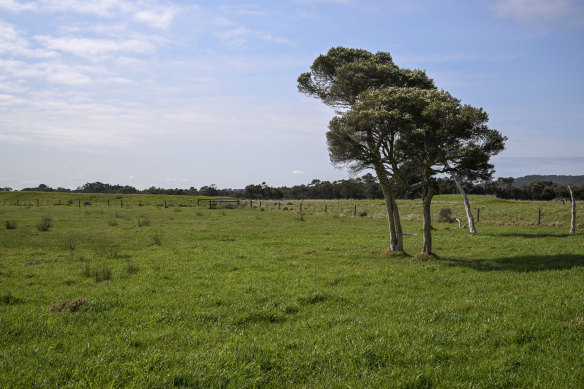This was published 6 months ago
Mornington Peninsula solar farm will mix power with fruit and veg
An unremarkable patch of grazing land on the Mornington Peninsula will be transformed by the installation of 13,000 solar panels nestled among crops of fruit and vegetables.
The backers of this “agri-solar” project, near sought-after residential property in coastal suburbia, say they are breaking new ground and that there are few examples in Australia combining solar energy generation and horticulture.

Mornington Peninsula Shire mayor Simon Brooks (left) with Stephen Todd and Dromana Industrial Association members Georgina and John Plumridge. Credit: Eddie Jim
Stephen Todd, who has taken out a lease on the land, said the project was a “greenhouse without walls” that would power all the horticultural activities on the property, provide vehicle chargers on site and produce enough electricity to power about 1200 homes.
Todd plans to grow raspberries, currants and mushrooms, as well as native species, including finger limes and lilly pillies on the Dromana site. He hopes the project will be operating by late next year.
Solar farms have proven deeply unpopular in many communities in the past, with complaints about glare and aesthetic harm to the landscape.
But Todd said the Collins Road project was small compared with other solar farms and would be bordered by lemon and apple trees, providing a more attractive vista for neighbours and passersby.

The block of land in Dromana set to host 13,000 solar panels. Credit: Eddie Jim
Todd, who is also founder of the company Volt Farmer, insisted the project also had broad backing, with residents, businesses and Rotary involved in its design.
“It will essentially disappear into the landscape,” he said.
While it is becoming more common for farmers to graze sheep alongside panels on solar farms, Todd said growing fruit and vegetables on such farms was only just beginning in Australia. It is more commonplace in Europe.
Glassy panels would allow some sunlight to reach the ground and large avenues would also ensure the plants would not be overshadowed, he said.
The project already has the support of the Mornington Peninsula Shire. The property falls within a green wedge, which means it cannot be developed for residential purposes.
Mayor Simon Brooks said his experience in local government had shown there was always pressure from developers to extend town boundaries, especially in sought-after areas like Dromana.
Figures from property site Domain show the median price for a three-bedroom house in Dromana is almost $900,000.
“If the urban growth boundary was to be moved, that land would be very valuable for housing,” he said. “Dromana is pretty well full.”

Although it is becoming more common to run sheep among solar panels in Australia, horticulture and solar are a less common combination. Credit: Janie Barrett
Brooks said the council supported the project because it wanted to ensure agriculture had a long-term future on the Mornington Peninsula, particularly with climate change threatening to inflict longer droughts in much of Australia.
“We understand that we’re increasingly going to be part of Melbourne’s food bowl, particularly as things dry out towards the north.”
He said energy network company United Energy had previously expressed concerns about the ability to maintain power to some parts of the peninsula, particularly when the population surges during the summer holidays.
La Trobe University agriculture expert Kim Johnson said there were not many examples of combined solar and horticulture projects in Australia and this was a missed opportunity.

The site chosen for a solar farm in Dromana. Credit: Eddie JIm
“Agri-solar offers so much opportunity and potential. There’s a lot of talk about it,” she said. “But to date, there’s not a lot of area it’s being performed in.”
United Energy’s head of network planning, Andrew Dinning, said demand during the peak summer tourism season had been growing steadily on the Mornington Peninsula. The company had used batteries and back-up generation in the past, including diesel generators, he said.
This week the company released plans to build a 54-kilometre “backbone” powerline between Hastings and Rosebud to provide additional power to the peninsula.
However, the company declined to comment on the Dromana solar farm, saying it would not comment on specific projects but always worked closely with any developments seeking a connection to the United Energy network.
The Morning Edition newsletter is our guide to the day’s most important and interesting stories, analysis and insights. Sign up here.